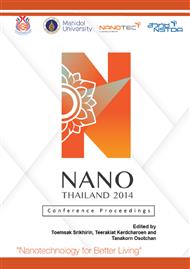p.25
p.35
p.39
p.43
p.49
p.53
p.60
p.64
p.71
Study of Optical and Electrical Properties of Bismuth-Doped Copper Phthalocyanine Thin Films Grown by Thermal Co-Evaporation
Abstract:
Bismuth-doped copper phthalocyanine (Bi-doped CuPc) thin films were grown by organic-source thermal co-evaporation under five different deposition rates. Morphological, optical and chemical properties of the doped-films were characterized by atomic force microscopy (AFM), field emission scanning electron microscopy (FESEM), UV-Visible spectroscopy and X-ray photoelectron spectroscopy (XPS). Furthermore, electrical properties of ITO/Bi-doped-CuPc/Al devices i.e. carrier mobility and carrier concentration were characterized by current-voltage and capacitance-voltage measurements. Morphology of the doped films shows strong dependence on preparation conditions, as clearly observed by features of film surface i.e surface grain size and roughness. Optical absorption spectra of all doping conditions provide regular three dominant α-phase peaks at 339, 620 and 695 nm corresponding to absorption from B-band and Q-band, respectively. Electrical properties exhibit the enhancement of the film conductivity due to increase of both carrier mobility and carrier concentration with higher Bi-doping level. Moreover, photoelectron analysis reveals chemical information of the metal dopant in the host material.
Info:
Periodical:
Pages:
49-52
Citation:
Online since:
December 2015
Price:
Сopyright:
© 2016 Trans Tech Publications Ltd. All Rights Reserved
Share:
Citation:


